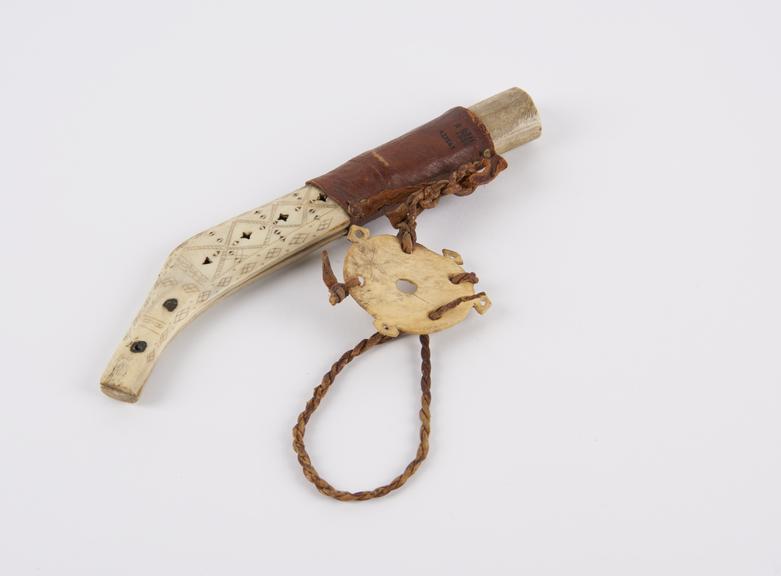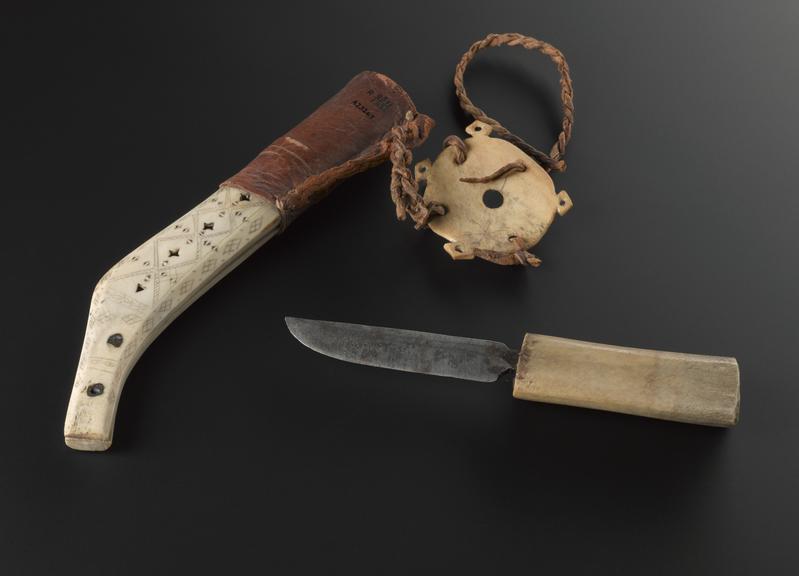





Steel knife, with sheath made of reindeer horn decorated with ornaments, a reindeer leather cuff on top of the sheath, as well as a carved bone disc attached, Sámi, Sápmi, Northern Europe, 1890-1920
For the Sámi, the Indigenous people of northern Norway, Sweden, Finland, and the Russian Kola Peninsula, handicrafts have for centuries been a substantial part of culture, identity, and livelihood. In Northern Sámi language, these handicrafts are called ‘duodji’.
Originally hunters and gatherers, the Sámi have been herding domesticated reindeer since the 17th century. Until the colonial rule forced them to settle down, they led a nomadic life and moved their herds from winter to summer grazing lands, following the changes of the seasons.
Using materials from nature, such as roots and birch bark, as well as reindeer horn, sinew, and skin, they manufactured all their clothes, gear, and tools themselves. Later, traded products like silver, cloth, and tin thread were added. Every item in possession fulfilled a purpose and was adapted to life on the move. Often, items that were used in everyday life, such as knives, needle holders, or tobacco pouches, were carried on a belt that is part of the traditional Sámi clothing.
Knives are one of the most important examples of Sámi ‘duodji’ and have for a long time been an essential tool in Sámi communities. Different types and sizes of knives fulfil different purposes and are used for butchering tasks, cleaning fish, de-limbing and cutting small trees, as well as marking the ears of reindeer calves. Knives and their sheaths are usually made of steel, reindeer horn, leather, and wood. Manufacturing them isn’t an easy task and requires a lot of training. The level of a maker’s skills becomes evident in how elaborate and detailed the knife’s shape and engravings are. Sámi engravings are not just used for decoration purposes. Varying from region to region, they can provide information such as the artist’s or owner’s gender, marital status, or where they come from.
‘Duodji’ has changed over time but is still an important part of Sámi heritage that is actively practiced and the basis of many Sámi artists’ businesses and livelihoods. It is passed on from generation to generation, but also taught at schools and can be studied at universities or in apprenticeships.
Details
- Category:
- Ethnography and Folk Medicine
- Collection:
- Sir Henry Wellcome's Museum Collection
- Object Number:
- A23263
- type:
- knife
- credit:
- Wellcome Trust (Purchased from Stevens)




